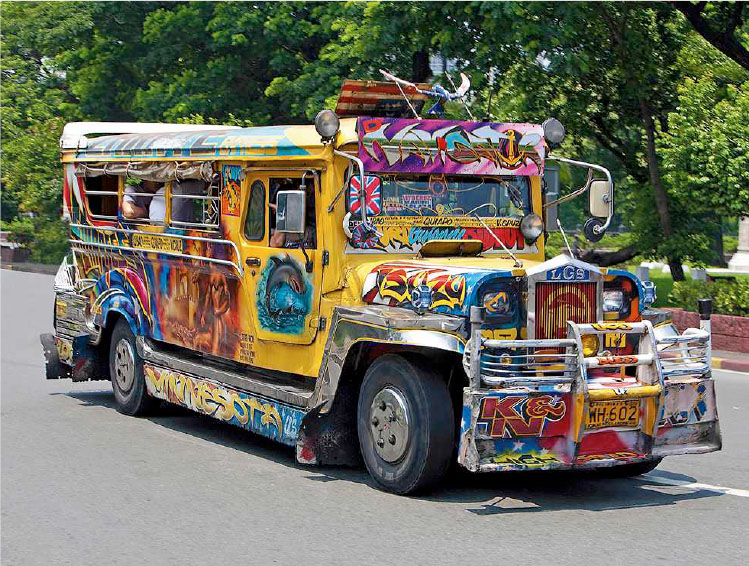
Source: SEATOPS/ALAMY
Upon the conclusion of World War II, the Philippines was in need of a new public transportation system due to damage sustained during the war. As the American forces that occupied the country at the time began to head home, they left behind military Jeeps that were eventually retrofitted to transport passengers. Despite initially being a temporary solution to the nation’s public transportation needs, jeepneys have become the backbone of how people get around throughout the country. Often adorned with brightly painted designs and roaring engines, the Jeepney has become an iconic symbol of Filipino innovation and resilience. With as many as 270,000 jeepneys in operation and a 9-piso fare ($0.18) it is no wonder that it serves as the country’s main transportation system, despite a plethora of other options [1].
Phasing out jeepneys

Source: Noel Celis/AFP/Getty Images
In 2017, the DOT launched the Public Utility Vehicle Modernization Program (PUVMP), which calls for the phasing out of traditional jeepneys as part of its plan. The goal of this program is to make the country’s transportation system more efficient and environmentally friendly than it currently is. Anyone that has spent time on the streets of Manila knows just how fragmented the current system is. While jeepneys typically have set routes, drivers will often drive at a snail’s pace along the side of the road while trying to hail passengers if it is not full. When they are full, they can be seen speeding through traffic trying to get through their route as quickly as possible. Add in private vehicles, trikes, buses, motorcyclists, and cabs and the roadways can be completely chaotic. As a result, the capital city Manila has some of the world’s worst traffic congestion [2] The diesel jeepneys also account for 15% of the particulate matter emissions in Metro Manila and it is not uncommon to get a plume of black smoke in your face while walking down the street [1]. Given that jeepneys contribute significantly to both traffic and harmful pollutants, it is understandable that the government wants to modernize the transportation.
As outlined by the PUVMP, standards will require new public utility vehicles to be powered by a Euro IV diesel engine (or better) or electricity, and they may be equipped with modern features such as air conditioning, GPS, a dashboard camera, CCTV, speed limiters, and an automated fare collection system. As part of a study conducted by GIZ, the first of these vehicles were launched in 2018 and found that the modernized routes performed better than traditional jeepneys in terms of vehicle operating hours, number of staff employed per vehicle per day, fuel economy per passenger per km, and daily ridership. Daily staff earnings also remained similar and also had benefits on top of that. Early implementation was by and large a success, with the majority of the modernized jeepney operators indicating a strong desire to increase fleet size and expand to new routes [3].
Not without a fight
The approval of the PUVMP and the intention to phase out existing jeepneys has been met with fierce opposition from owners and passengers alike. Despite having one of the world’s fastest growing economies at over a 6% average between 2010 and 2019, the country still has 16.7% (2018) of its population living below the National Poverty Line [4][5]. Removing the cheapest form of widespread transportation and replacing it with a costlier alternative could have devastating effects on those living in poverty or on the fringes of poverty. One of the primary concerns at this point is that it appears that jeepney drivers are going to be the ones that need to shoulder the costs of this transition towards modernization, which will surely be passed on to those use them. With upgrade costs ranging from 1.6 million PHP to 2.2 million ($33,200-45,700), it is well beyond what most Filipinos can afford [6]. Also, from a purely cultural standpoint these modernized “jeepneys” more closely resemble minibuses, which is a large shift away from the traditional jeepney that serve as a national symbol that represents so many of the nation’s residents.
Conclusion
The transportation system in the Philippines is definitely in need of modernization and the proposal to replace dilapidated public vehicles is understandable. Modern jeepneys definitely offer a more comfortable ride and emit far less pollutants than those that are currently operating. The backlash towards modernization is primarily due the fact that it looks like this transition will prioritize profits under the guise of helping the environment over equity. People are not necessarily opposed to the modernization of the transportation system. Presumably, most people would favor it if it meant a more comfortable ride, less pollution, and better services. Jeepneys are synonymous with daily life in the Philippines and it is imperative that the people who use them are apart of the planning process moving forward to ensure they are not left behind.
[5] https://www.adb.org/countries/philippines/poverty
[6] https://thediplomat.com/2020/12/philippine-jeepneys-wont-go-down-without-a-fight/
